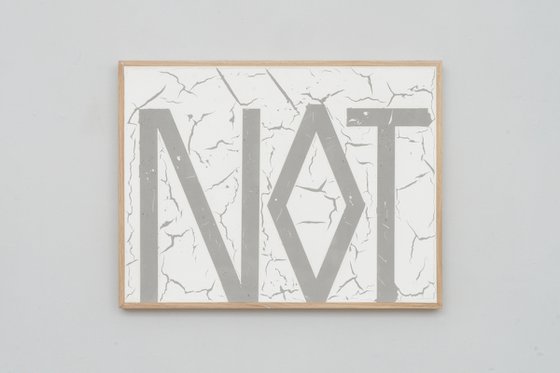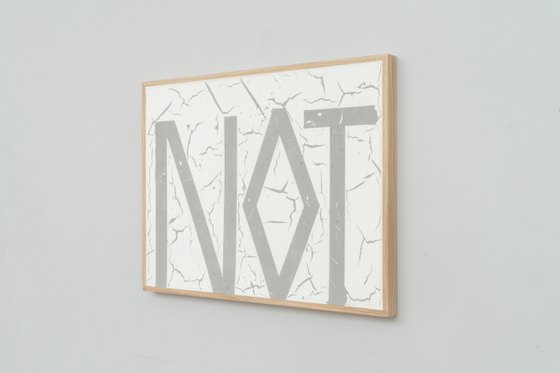Main Navigation
Original artwork description:
Filler, oak frame
This work is supposed to be installed to give the impression it has been accidentally forgotten and left in a somewhat secluded space.
Language and visuality are tightly connected. Anything not adequately introduced to the symbolised universe is difficult to notice. It remains invisible in plain sight. We need to be able to express what we see to perceive it. Still, many or maybe most things exist outside this realm. We're aware of just a small portion of what we experience. These things still affect us, and we manoeuvre accordingly, but we do it unconsciously.
Some things challenge our world view, and thus we reject them from being verbalised and brought to the level of consciousness. It particularly concerns the matter of privilege. In order of maintaining a system of privilege, the demands for equality from the marginalised remains unseen, or they are made invisible altogether. That's is why representation is key to a genuinely democratic society.
About Tablet series
To the mind, a word is always also an image. Language connects to categories and clusters of information that projects an internal image when triggered. In that sense, understanding words function no different than normal perception. When we see, images are constructed inside the mind. We never perceive reality objectively or in itself. Perception is an interpretation and thus consist of language, in the same manner as understanding words.
However, as vision usually stems from physical reality, so does also words, written or spoken. Nothing ever communicates without being inscribed into a matter of some sort. The stuff surrounding us is also what connects us; without it, we would be completely sealed off. How, or in what way, words inserts into reality affects how we perceive them. Thus reality itself seeps into language. There exists no clear or unmediated communication. Matter adds to the message. Because which matter we choose to communicate through reflects on who we are, it can also help to reveal unconscious or hidden meanings.
The first written words were inscribed in stone or clay. One of the purposes was to save them for the future, to protect them from the volatility of time. To speak, or to write, is always to some extent, an act of power. The receiver must initially submit his or her attention to the message. No matter how insignificant, its meaning will always change the receiver forever. The receiver usually processes the reception, but he or she will never be the same as before. It is no coincident that many of the first examples of texts are curses, prayers or laws — different ways of trying to influence reality.
Materials used:
Filler (coarse and fine) in oak frame
Tags:
#abstract #painting #minimalism #filler #oak frame#263 Represented (2020) Painting
by Johan Söderström
1 Artist Reviews
£1,665.16
- Painting on Panel / Board / MDF
- One of a kind artwork
- Size: 84 x 64 x 5cm (framed)
- Framed and ready to hang
- Signed on the back
- Style: Graphic, illustrative and typographic
- Subject: Abstract and non-figurative
Loading
Original artwork description
Filler, oak frame
This work is supposed to be installed to give the impression it has been accidentally forgotten and left in a somewhat secluded space.
Language and visuality are tightly connected. Anything not adequately introduced to the symbolised universe is difficult to notice. It remains invisible in plain sight. We need to be able to express what we see to perceive it. Still, many or maybe most things exist outside this realm. We're aware of just a small portion of what we experience. These things still affect us, and we manoeuvre accordingly, but we do it unconsciously.
Some things challenge our world view, and thus we reject them from being verbalised and brought to the level of consciousness. It particularly concerns the matter of privilege. In order of maintaining a system of privilege, the demands for equality from the marginalised remains unseen, or they are made invisible altogether. That's is why representation is key to a genuinely democratic society.
About Tablet series
To the mind, a word is always also an image. Language connects to categories and clusters of information that projects an internal image when triggered. In that sense, understanding words function no different than normal perception. When we see, images are constructed inside the mind. We never perceive reality objectively or in itself. Perception is an interpretation and thus consist of language, in the same manner as understanding words.
However, as vision usually stems from physical reality, so does also words, written or spoken. Nothing ever communicates without being inscribed into a matter of some sort. The stuff surrounding us is also what connects us; without it, we would be completely sealed off. How, or in what way, words inserts into reality affects how we perceive them. Thus reality itself seeps into language. There exists no clear or unmediated communication. Matter adds to the message. Because which matter we choose to communicate through reflects on who we are, it can also help to reveal unconscious or hidden meanings.
The first written words were inscribed in stone or clay. One of the purposes was to save them for the future, to protect them from the volatility of time. To speak, or to write, is always to some extent, an act of power. The receiver must initially submit his or her attention to the message. No matter how insignificant, its meaning will always change the receiver forever. The receiver usually processes the reception, but he or she will never be the same as before. It is no coincident that many of the first examples of texts are curses, prayers or laws — different ways of trying to influence reality.
Materials used:
Filler (coarse and fine) in oak frame
Tags:
#abstract #painting #minimalism #filler #oak frame14 day money back guaranteeLearn more







